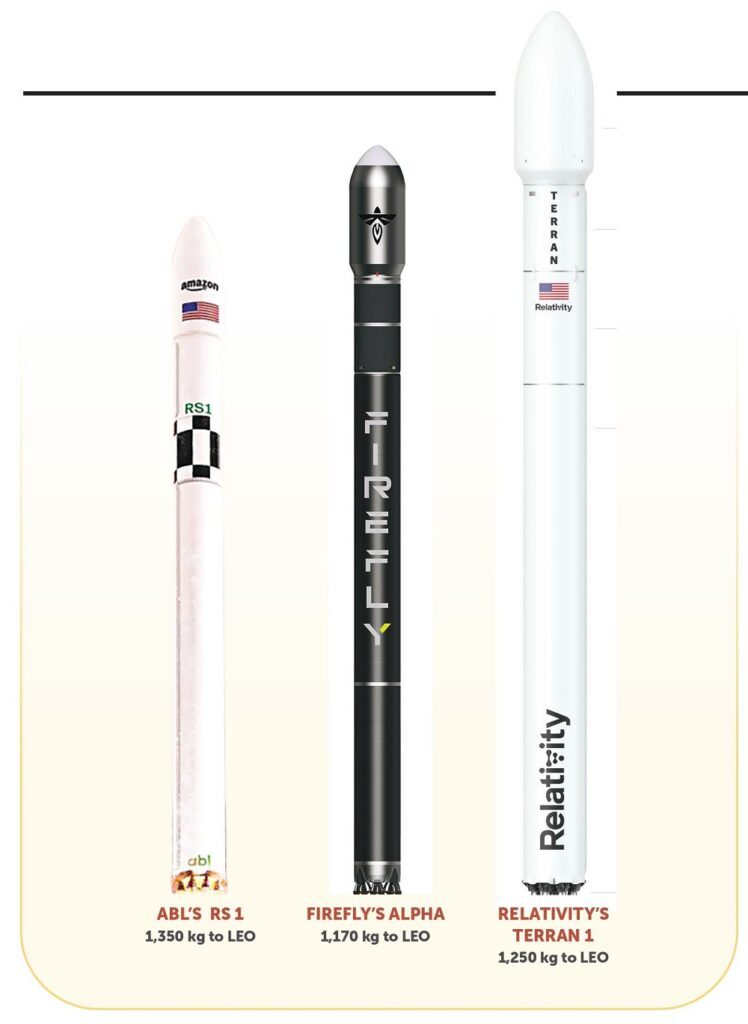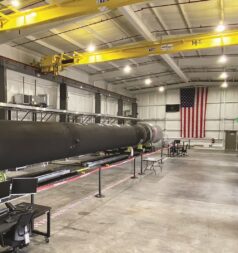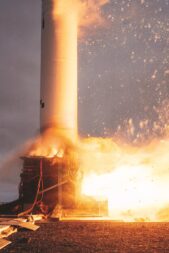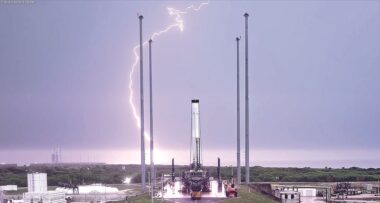21.08.2022

Most of the enthusiasm about small launch vehicles has focused on the very smallest ones, those capable of placing a few hundred, and in some cases just a few dozen, kilograms into low Earth orbit. Some of them have been quite successful, like Rocket Lab’s Electron, which has launched five times in the first seven months of the year. Others, less so: Astra’s Rocket 3 has failed in five of its seven orbital launch attempts, including its most recent launch in June with two NASA Earth science cubesats on board.
In the next few months, though, the industry’s attention will shift to a larger class of rockets, sometimes called ”mini-launchers,” capable of placing about a metric ton into orbit. Firefly Aerospace is gearing up for its second Alpha launch a year after its inaugural flight failed, but with more changes at the company than on the rocket. Two other companies, ABL Space Systems and Relativity Space, are preparing for their first launches.
ALPHA’S SECOND CHANCE
Last September, Firefly’s first Alpha lifted off from Vandenberg Space Force Base — and was almost immediately doomed. Fifteen seconds after liftoff, one of four first-stage engines shut down because of what the company later determined to be a faulty electrical connection that closed propellant valves. The rocket continued to ascend for two minutes until it reached maximum dynamic pressure, causing it to tumble. Range termination systems then blew up the rocket.
The fix for that specific problem was straightforward, but the company has used the time since the failure to improve how it produces rockets. “What we’ve done in the year since we launched is a step change in the processes that we have internally,” Peter Schumacher, interim chief executive of Firefly, said in an interview in July. “It’s around ensuring that the product sitting out there is the absolute best product that we can produce.”
The second Alpha is in a hangar at Vandenberg and is ready for launch, other than conducting a wet dress rehearsal and static-fire test that Schumacher estimated will take place about two weeks before launch. Firefly, for now, is waiting on a launch license from the Federal Aviation Administration and then working around other launches at Vandenberg.
That license is pending work on a new debris model for Alpha launches. When the range detonated the first Alpha rocket, debris drifted outside the expected corridor, in some cases landing in towns near Vandenberg. The debris, made of carbon composite materials, caused no damage but raised safety concerns.
“We have the unfortunate precedent of being the first large composite rocket ever to be terminated,” Schumacher said. The debris model they had used assumed rockets with metallic structures, which break up differently than composite ones. Firefly worked with another company and the FAA on an improved model that was nearing final approval.
Depending on when the company received its FAA launch license and the schedule of other launches from Vandenberg, he predicted Firefly would be ready to attempt an Alpha launch in late August or early September.
Firefly itself has arguably changed more in the last year than its Alpha rocket. Max Polyakov, the Ukrainian entrepreneur who rescued the former Firefly Space Systems from Chapter 11 bankruptcy in 2017, put his majority stake in the company up for sale in December 2021 at the request of the Committee on Foreign Investment in the United States (CFIUS). Firefly didn’t explain what prompted the CFIUS request but speculated it was linked to rising tensions ahead of Russia’s invasion of Ukraine.
Polyakov’s Noosphere Venture Partners sold that stake in Firefly in February to AE Industrial Partners (AEI), a private equity firm that created Redwire Space in 2020 through the acquisition of several space technology companies and invested in Sierra Space, Terran Orbital and Virgin Orbit. AEI led a $75 million Series B round raised by Firefly in March.

In June, Tom Markusic, co-founder of Firefly, announced he was stepping down as chief executive but would remain on the company’s board and serve as a chief technical adviser. Schumacher, a partner at AEI, stepped in as interim chief executive.
He made it clear in the interview that he does not plan to lead Firefly for long. The company has hired a recruiter, Korn Ferry, to identify candidates for the job, with a goal of having a new chief executive in place by mid-August.
In the meantime, Schumacher said he’s been working to find ways Firefly can benefit from other AEI portfolio companies. That included bringing in executives from Atlas Aerospace, which makes aircraft components such as doors used on the Boeing 737. “They went through the entire machining, production and assembly areas at Firefly and brought their expertise to bear,” he said. “They’re working to bring efficiencies in and machining times down to a quarter of what they were before.”
That efficiency is needed as Firefly looks to increase its launch rate in 2023. If the upcoming Alpha launch is successful, Firefly expects to conduct another Alpha launch late in the year, carrying cubesats on a contract through NASA’s Venture Class Launch Services (VCLS) program. The company is planning up to six launches in 2023.
Schumacher said Firefly will build rockets on a schedule and then find customers for them rather than produce rockets once contracts are signed. “I’m getting the company on the mindset that we need a rocket manufactured every two to three months,” he said. “Then I put it on the business development team to go sell that rocket. So, regardless of whether or not we have a paying customer, we’re going to have a rocket ready.”
That approach could give Firefly the flexibility to pursue customers who need launches on short notice, such as national security responsive launch programs. The company is also in the process of being added to NASA’s Venture-Class Acquisition of Dedicated and Rideshare (VADR) contract for smallsat launches. The company missed out on VADR when NASA announced an initial set of 12 providers in January, Schumacher said, because the CFIUS request forced the company to break off negotiations with NASA.
RS1 AND TERRAN 1
While Firefly prepares for its second Alpha flight, two other companies are gearing up for the first flights of similarly sized rockets. ABL Space Systems has its first RS1 rocket at Pacific Spaceport Complex – Alaska on Kodiak Island, going through the final preparations for its inaugural launch.
That included a static-fire test of the rocket’s first stage at Kodiak on July 9, confirming it was ready to fly. “The operation verified our startup sequence and stage level engine performance,” said Harry O’Hanley, chief executive of ABL, noting the company completed the test on the first try.

RS1 is a vehicle capable of placing up to 1,350 kilograms into low Earth orbit for $12 million a launch. The vehicle has Lockheed Martin as an anchor customer: the aerospace giant signed a contract in 2021 for up to 58 RS1 launches over the next decade, and also selected the rocket to perform a “U.K. Pathfinder” launch for the U.K. Space Agency from the Shetland Islands in 2023.
ABL was on a path to conduct the first RS1 launch earlier this year, but the upper stage it built for that launch was destroyed in a testing mishap in January at the Mojave Air and Space Port in California. O’Hanley said that the upper stage engine suffered a “hard start”: an explosive rise in energy in a rocket engine when propellants are ignited. The hard start triggered a fire at the aft end of the stage that led to the complete failure of the stage 20 seconds later.
Before the failure, ABL expected to be ready for a first launch as soon as February from Kodiak. The company completed a new upper stage and ran a series of acceptance tests in May, correcting the flaw that caused the hard start.
Dan Piemont, president of ABL, said in mid-July the company was still conducting post-test analysis. “It’s premature to set a launch window,” but projected a minimum of four to six weeks, or sometime in the latter half of August, before the company would be ready for a launch. As of late July, the company did not yet have an FAA launch license, nor had aviation or maritime notices of a launch been issued.
At Cape Canaveral, Relativity Space has been performing tests of its first Terran 1 rocket at Launch Complex 16. That included briefly igniting the nine engines in the first stage. The company has not set a launch date for the mission, whimsically named “Good Luck, Have Fun,” but has suggested it could take place in the next couple of months.
Relativity is best known for making extensive use of additive manufacturing to produce the rocket. Even as it tests the first Terran 1 on the pad at Cape Canaveral, it is printing the second Terran 1 for a NASA VCLS mission at its Long Beach, California, factory.

The Terran 1, capable of placing up to 1,250 kilograms into low Earth orbit, is in danger of being overshadowed by the much larger Terran R, a fully reusable launch vehicle Relativity announced last year with a payload performance similar to SpaceX’s Falcon 9. Relativity estimates having the Terran R ready as soon as 2024. It has a backlog of more than 20 launches under contract, including a deal with OneWeb announced in June for its second-generation satellites.
Relativity says it has five Terran R customers but has only identified OneWeb. Tim Ellis, chief executive of Relativity, called those other customers “top satellite operators we are extremely excited about having on our manifest.”
Relativity has announced several customers for Terran 1, including Iridium and Telesat, the latter for its future LEO constellation. The Iridium contract, announced in June 2020, included up to six launches, each carrying a single spare satellite currently in ground storage.
However, Iridium announced July 26 that it signed a contract with an unnamed company to launch five of its spare satellites next year for $35 million. In an earnings call, Matt Desch, chief executive of Iridium, said the launch contract was not with Relativity but declined to name the provider. Iridium previously launched its satellites on Falcon 9 missions, including five on one launch it shared with an Earth science mission.
Desch said Iridium’s contract with Relativity remains in effect. “It offered the opportunity to launch but didn’t require a specific number of satellites to launch,” he said. With the contract with the unnamed provider for five satellites, Iridium has just one spare left to launch on a Terran 1.
Firefly’s Schumacher is keeping an eye on the competition but feels his company has an advantage given its experience with its first launch attempt and overall capabilities. “The more I learned, the more I am excited about where Firefly is,” he said. “Our competitors may make the news more and they’re a little more splashy, but when you think about where they are relative to where we are, we are in such a better position from a technology perspective and a maturity perspective.”
“Once we demonstrate our technology on this flight,” he said of the upcoming Alpha launch, “the market is going to see what I see where we are relative to our competitors and be quite impressed.”
Quelle: SN
